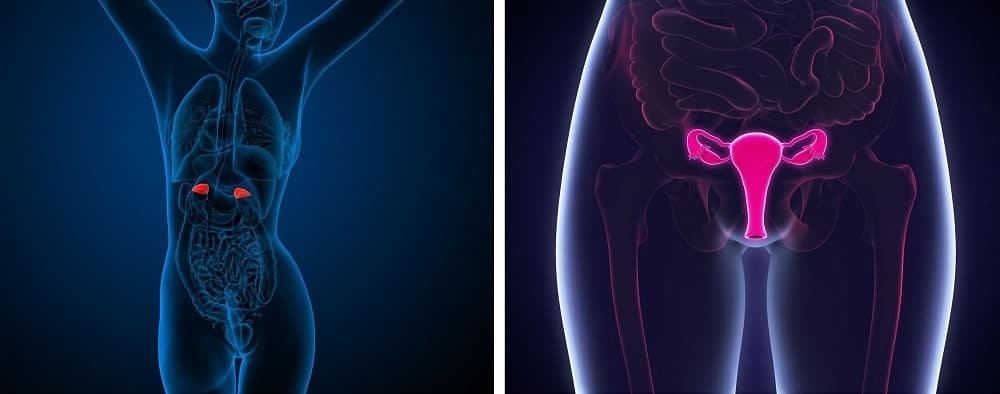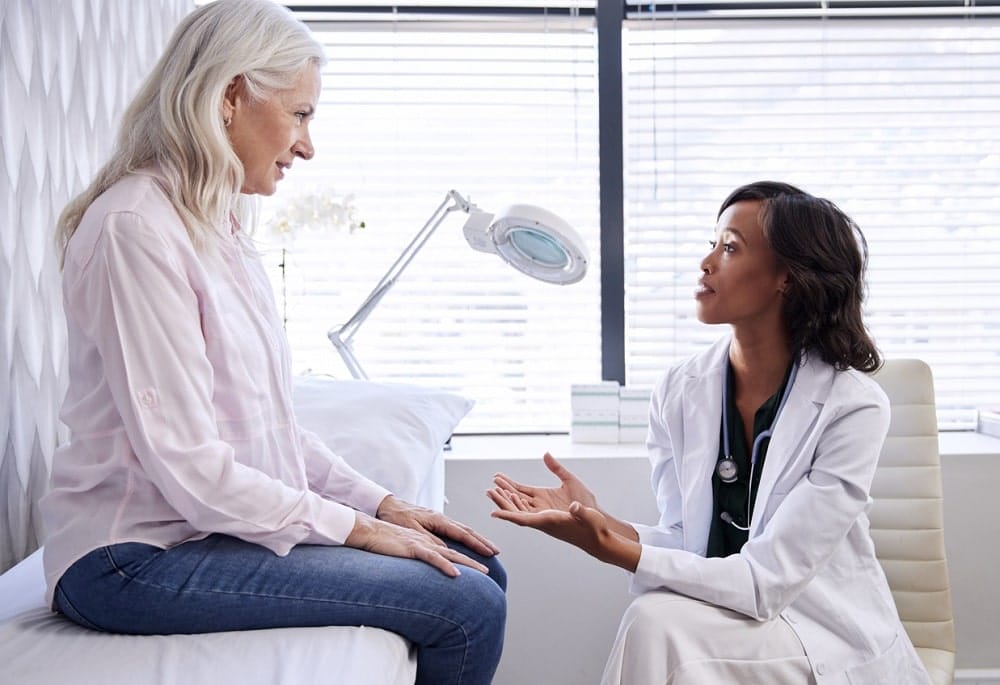Table of Contents
Just as with men, low testosterone in women can have dire consequences if left untreated. Many women do not think about testosterone because it is often viewed as the male sex hormone. While testosterone does fuel a young man’s sexual development, that is far from its only function. In this review, we look at the impact of low testosterone on the female body, the method of production, symptoms, and causes of Low T, and the best way to treat declining testosterone levels.
Females typically experience a change in vital hormone levels as they approach menopause. For those who undergo an oophorectomy (surgical removal of the ovaries), the decrease in hormone levels is instantaneous. Surgical menopause results from the loss of ovarian hormone production of estrogen, testosterone, DHEA, and progesterone.
Aside from influencing sexual desire, even in women, testosterone also plays leading roles in the following areas:
- how the body metabolizes the food it consumes
- brain functions and emotional well-being
- heart health
- red blood cell production
- fat and muscle mass distribution – body composition
- bone mineral density
- fertility
Females dealing with Low T can experience changes in any or all of these areas. Low testosterone in women is easy to detect and treat. An endocrinologist (a doctor who treats hormonal imbalances) can determine who is a candidate for treatment.
Low T in women can impact the body in many ways, including physical, mental, and emotional decline.
Testosterone Production in Women
Unlike men, who get most of their testosterone from their gonads (testes), women produce only a small amount of testosterone in that way. The ovaries account for about 25% of a woman’s testosterone. Another 25% is produced in the adrenal glands. The remaining 50% of testosterone is produced throughout a woman’s body in her peripheral tissues, where the precursor hormones that come from the adrenal glands and ovaries stimulate the testosterone synthesis.
Low testosterone in women can occur when testosterone production in any of these areas declines. The hypothalamus helps regulate testosterone levels by measuring how much testosterone is in the bloodstream. If levels seem low, the hypothalamus sends gonadotropin-releasing hormone (GnRH) to the pituitary gland to stimulate the production of luteinizing hormone (LH). Then, LH stimulates precursor hormone conversion into testosterone.
Testosterone starts as cholesterol, which, using various enzymatic processes, converts into pregnenolone, then either progesterone or DHEA, before becoming androstenedione – the direct precursor to testosterone. If a woman has low progesterone or DHEA levels, she will likely suffer from Low T, as well.
A woman produces DHEA primarily in the outer layer of the adrenal glands, along with a small amount in the ovaries. Progesterone production occurs in the ovaries, adrenal glands, and placenta. As you can see, even after menopause, the female body does still produce some progesterone, DHEA, and testosterone.
Estrogen production is slightly different. While most of the estrogen production occurs in the ovaries, a small amount also comes from the adrenal glands and fat cells. It is there, in the fat cells, that the cause of low testosterone levels in menopausal and postmenopausal women often occurs.
Once the ovaries stop their functions, the majority of the hormone production occurs in the adrenal glands, fat cells, and peripheral tissues. Belly fat provides the body with an increased supply of aromatase, an enzyme responsible for the conversion of testosterone into estradiol, the primary form of estrogen. The more belly fat a woman has, the greater the conversion rate – often leading to a lower testosterone to estrogen ratio. That results in a condition called estrogen dominance which further increases the following risks:
- high blood pressure
- weight gain
- insulin resistance
- diabetes
- thyroid problems
- breast cancer
- depression
- fatigue
Low testosterone in women is often linked to a condition called estrogen dominance, which can have dire consequences for female health.
Meaning of Low Testosterone (Low T) in Females Body
Reference ranges for low testosterone in women differ from one lab to the next, showing anywhere from 8 to 60 ng/dL at one lab to 15 to 70 ng/dL at another. Women under age 50 are often considered to have low testosterone if they have less than 25 ng/dL. For females over age 50, the levels drop to below 20 ng/dL.
Since the female menstrual cycle also affects testosterone levels, it is best to time the blood test to a period of 8 to 20 days after the onset of menstruation.
The signs of Low T are easy to detect – once you know what to look for. The causes of declining testosterone levels are sometimes a bit harder to ascertain, especially in younger women who are far from menopausal age. Effects stemming from testosterone deficiency can often vary due to the many roles testosterone plays in the body. We examine the symptoms, causes, and effects of low testosterone in women below:
Symptoms
Because testosterone is the body’s primary sex hormone, a woman may exhibit symptoms of low libido, slow arousal, vaginal dryness, and decreased orgasm intensity. She may stop having sexual fantasies and dreams.
Other symptoms of female low testosterone levels include:
- Weight gain – primarily abdominal
- Muscle loss
- Reduced strength
- Decreased bone density and increased osteoporosis risk
- Insulin resistance
- High blood pressure
- Anemia
- Infertility
- Fatigue
- Sleep disturbances
- Irregular menstrual cycles
- Depression
- Stress, anxiety, irritability
- Hot flashes
- Night sweats
- Decreased motivation
- Social isolation
- Forgetfulness/brain fog
- Thinning hair or hair loss
- High LDL and total cholesterol
Causes
There are two primary causes of low testosterone in women:
- Aging and menopause
- Problems stemming from hormone production either due to the hypothalamus, pituitary gland, ovaries, or adrenal glands (tumors and injury can influence hormone production)
Effect
If left untreated, low testosterone can have dire consequences for a woman, increasing her risk of the following medical issues:
- Type 2 diabetes
- Atherosclerosis
- Cardiovascular disease
- Osteoporosis
- Dementia
- Obesity
- Depression
- Breast cancer (if associated with estrogen dominance)
Options To Increase Testosterone Levels
The treatment of low testosterone in women is a complex therapy that should only be prescribed and overseen by a hormone specialist. Determining the best treatment options depends on factors such as the level of testosterone, a woman’s health and body composition, age, and symptoms. Increasing one hormone level can affect others; that is why an expert in the field of hormone replacement is the best professional to contact.
In some cases, treatment may be as easy as making some lifestyle adjustments that could be hindering testosterone production. For other women, it may mean turning to professional medical intervention. These options are explained below:
Natural
For how to treat low testosterone levels naturally, the following options can help if symptoms of Low T are not yet severe:
- Ensuring adequate sleep – seven to nine hours each night is necessary to optimize testosterone release
- Losing weight – belly fat is a leading cause of testosterone conversion into estradiol (lowering testosterone and increasing estrogen levels)
- Reducing stress – the stress hormone cortisol opposes testosterone, inhibiting both sleep and testosterone production
- Exercising during the day – weight-bearing and high-intensity interval training can help increase testosterone secretion
Professional
Once testosterone levels have gotten low enough to cause significant symptoms, it is time for testosterone replacement therapy. The hormone specialist will measure numerous other hormone levels to ensure proper treatment. For women with estrogen dominance, an aromatase blocker may be prescribed to prevent testosterone conversion.
The best form of treatment is not the testosterone injection used by men, as the strength of the testosterone is too high for a female. Instead, our doctors prescribe effective testosterone cream, compounded by a pharmacy, to the exact strength and dosage requirements.
If left untreated, low testosterone in women can lead to many more dangerous health conditions.
FAQ About the Impact of Low T in Females
Do all women experience Low T and menopause symptoms?
No, even though every woman will undergo changes in hormone levels, not all will experience symptoms of menopause and Low T. Some females suffer from extreme hot flashes or night sweats, impeding their work or sleep. Others never have a single issue. Each woman’s body is unique in how she adjusts to changing hormone levels. Lifestyle habits and health also play a role in how declining testosterone levels impact the body.
Can Low T cause hair loss in women?
Yes, just as some of the body’s testosterone converts to estradiol, a portion also synthesizes into dihydrotestosterone (DHT). The enzyme 5-alpha reductase converts testosterone into DHT, which causes problems to the hair follicles. The more sensitive the hair follicles are to the effects of DHT, the greater the risk of hair thinning and loss. With age, the hair growth cycle also changes, decreasing the growing time and increasing hair loss.
Can Low T cause weight gain in women?
Not only is low testosterone in women a leading reason for weight gain, but Low T significantly increases fat retention – especially when estrogen dominance is present. It becomes one of those chicken or egg situations as to which came first. Unfortunately, we do not always have the answer. What we do know is that losing weight helps to increase testosterone production. In return, higher testosterone levels improve cardiac capacity for exercise, strengthen bones and muscles, reduce joint pains, and helps stimulate metabolism for increased energy and fat burning. Testosterone replacement therapy can also help with all the above.
Is there a connection between Low T and pregnancy issues such as infertility?
Yes, testosterone is crucial for female fertility. Testosterone helps prevent apoptosis – the early death of follicle cells. It helps to make the ovarian cells more sensitive to FSH (follicle-stimulating hormone), which is the promoter of follicle growth. With an increase of FSH receptors on the ovarian cells, a woman has better odds of conception.
To learn more about low testosterone in women, or for information on diagnostic testing and treatment options, please call our hormone clinic for a free consultation.





No Comments
Sorry, the comment form is closed at this time.